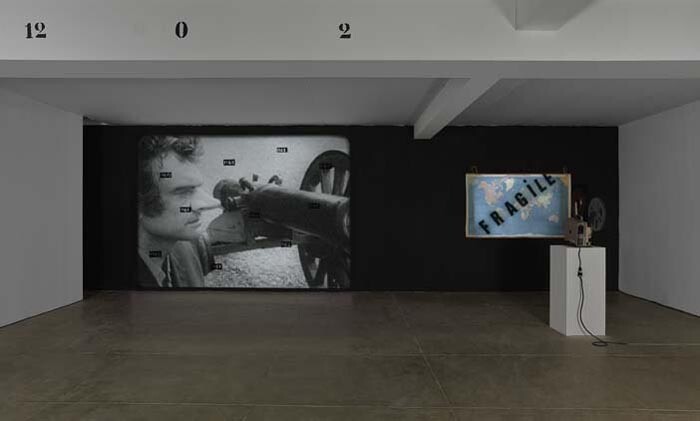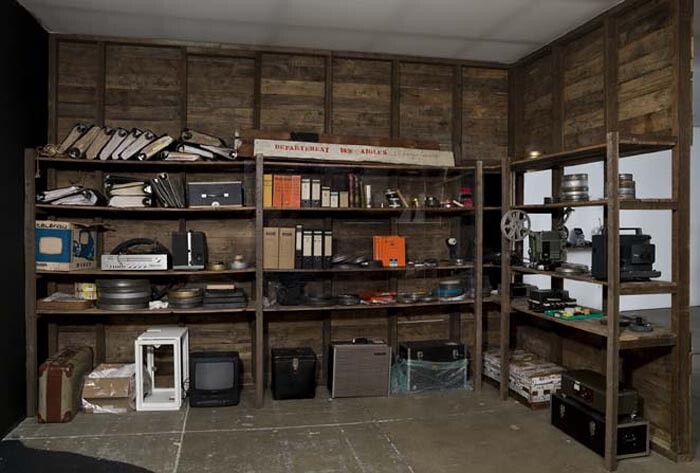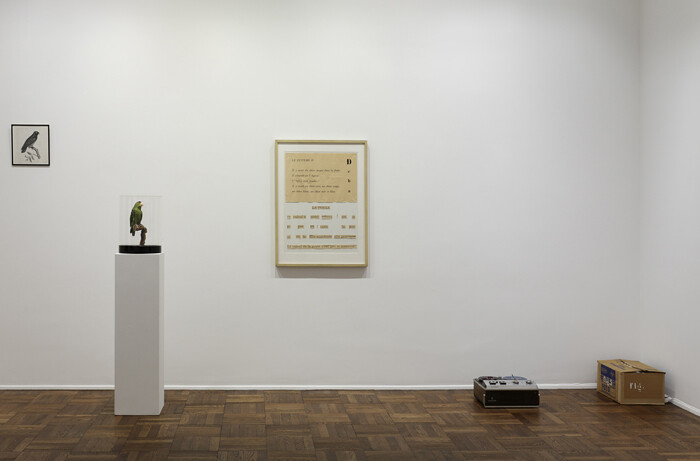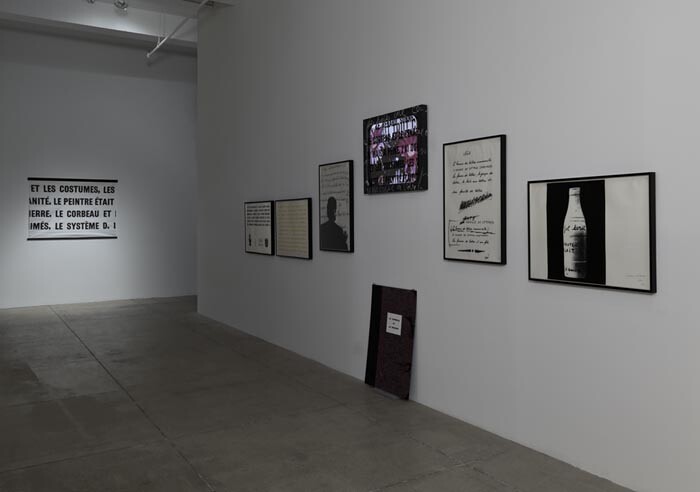There is an ambiguous theatricality to the recent Marcel Broodthaers exhibition at Marian Goodman. The gallery has reconstructed the 1972 Section Cinéma in its entirety (three carefully installed rooms of films and objects), alongside the work’s precursor, the 1970 Cinéma Modèle. The theatrical effect is a combination of intention and history: the everydayness of objects, the deliberate archaic quality of the technology, their inevitable ageing, and the artifice of new additions like the freestanding entrance “door.” Given that the work attempts theater, cinema, museum, and gallery in one gesture, the ambiguity is surely a sign that it has aged well.
Section Cinéma is an institutional fiction for Broodthaers’s film work. Opposite the entrance, two director’s chairs survey the scene. One projector shows Broodthaers’s Musée Museum against an altered world map (Carte du monde poétique, 1972), the second projector faces a screen stenciled with numbers—”Fig. 1,” “Fig. 2,” and so on—where Broodthaers’s own films are interspersed with newsreels, Chaplin films, and documentaries, in succession and in no clear order. Yet there is a manic pedagogy at work—the film screen, the ceiling beam, the walls, and objects are all are marked as “figures” and turned into illustrations for an invisible commentary.
Three decades from the work’s inception, its critique is not too hard to grasp. All meaning depends on absence: the insufficiency of language, the removes of visual representation, and the inevitable commodity status of art objects. The critique is also the legacy of Broodthaers’s larger project. Behind the main space, rough wooden walls create an enclosure that could be an archive, full of film reels, binders, and antique projectors. Then again, it could be an exhibition space: there is a vitrine filled with contact sheets and framed photographs and posters on the walls and floor. The centerpiece is a small key-less piano with a tiny eagle perched on its lid. The toy and its caption—”LES AIGLES”—connect the installation to Broodthaers’s fictional institution, the Musée d’Art Moderne, Département des Aigles (Museum of Modern Art, Department of Eagles), which he realized in different forms and locations between 1968 and 1972.
Broodthaers’s play with the authority of museums and language can be seen in another show at Michael Werner Gallery, timed in conjunction with the Goodman show. “Marcel Broodthaers: Major Works” was worth a visit if only for the 1974 Dites partout que je l’ai dit (Say Everywhere That I Have Said It), which includes a recording of Broodthaers announcing, in elegantly measured tones, that he is the King of Mussels—Le Roi des Moules, a play on the French word for “mussel,” “mold,” and “dope.” Whether it is a double-entendre involving Belgian staples or endlessly deferred chains of representation, repetition emphasizes the naïveté of attempting artistic autonomy.
The Goodman show continues with Cinéma Modèle, basically a grouping of five films that allows an unobstructed view of Broodthaers’s use of the medium. The films are all homages, ranging from La clef de l’horloge (The Key to the Clock, 1957), which reanimates Kurt Schwitters’s paintings in extreme chiaroscuro, to the one-liner La Pluie, ou Project pour un text (Mallarmé) (Rain, or Project for a Text, 1969), where the artist is drenched with a garden hose as he determinedly scribbles away. The final gallery presents Le Corbeau et le Renard: La Fontaine (The Raven and the Fox; La Fontaine, 1967) accompanied by a series of prints that open up the film’s dizzying textual layers.
“A unique synthesis of the obsolete, the infantile, and the imbecile,” Benjamin Buchloh writes of Section Cinéma in the accompanying catalogue. He means it as a compliment. Broodthaers’s work is appreciated above all for its abrasive edges—its deliberate illegibility, its dispersion across mediums and disciplines, its absurdist undermining of notions of truth and authenticity, and above all, for its dedication to maintaining those impossible positions as well as its sense of humor. In short, for the way it embodies the post-68 dilemmas of artistic commitment.
Goodman gave Broodthaers his first solo show in the United States when she opened her gallery in 1977. Section Cinéma is now a blue-chip commodity, the wry self-awareness of its creator notwithstanding. It is precisely this awareness that has maintained the work’s relevance: Broodthaers was one of the first artists to not only realize, but to accept the interdependent relationship of art and its ideological structures. Section Cinéma is neither a re-creation nor a rehearsal: it is a work made for a gallery setting as a perpetual representation of itself. As the recent installation demonstrates, Broodthaers’s poetic pessimism still has the ability to convey the conditions of its original moment—and perhaps some of the insights of its original critique—through its ambiguous object status.





